ZTE Grand X Review
ZTE Grand X
The most powerful Android phone £200 can buy?

Verdict
Pros
- Solid design
- Great value
- Vanilla Android ICS
- Tegra 2 offers great gaming at the price
Cons
- Gets hot under pressure
- Can't handle most HD video
- Some build quality quibbles
Key Specifications
- Review Price: £189.99
- 4.3in TFT 540 x 960 pixel screen
- 4GB internal memory
- Android 4.0 Ice Cream Sandwich
- Tegra 2 1GHz dual-core processor
The ZTE Grand X is an Android phone with a dual-core processor, a large screen and a half-decent camera, and it costs just £189.99. Specs-wise it should wipe the floor with the competition. Let’s find out if it does.
Design
Looking oddly similar to a rival phone from Samsung, the Galaxy Ace 2, the ZTE Grand X has a bit of a “me too” design. It’s out to look and feel like a typical mid-to-high end smartphone, rather than to make a fashion statement or be visually distinctive. It wants to fly under the radar, looking a bit like the other phones until you cast your eye over the price and exclaim, “bloomin’ ‘eck that’s good value for money.”
However, build quality compares reasonably well with that of better-known, more expensive alternatives. The front of the Grand X is covered by a sheet of glass, and its rear by a lightly rubberised soft touch plastic battery cover, with an embossed texture across the back to increase grip. No, it’s not unibody and there’s no metal to be seen here, but the phone has the solid feel we look for in top-end phones.
Start to challenge the phone a little more and some compromises become apparent. The glass front of the phone doesn’t seem to be particularly well-reinforced, as a mid-firm prod causes minor screen distortion, and the front soft keys are a little inelegant, and lack backlighting. There’s a tiny bit of creak to the right edge of the battery cover too.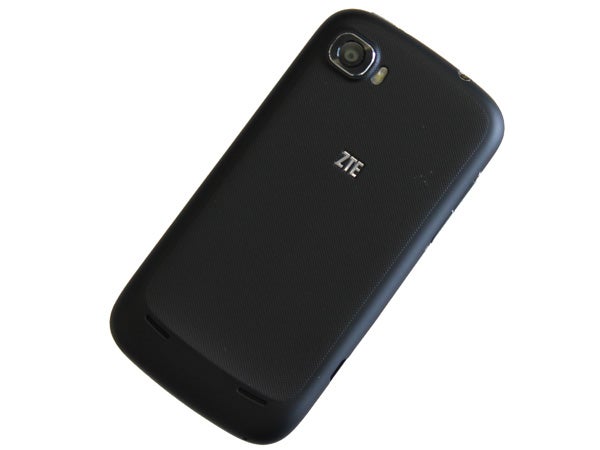
Unless you’re particularly accident prone, these are minor turn-offs. Quirks aside, you could slap an HTC logo on the phone and add a hundred pounds or more on to the price without raising too many eyebrows.
Connectivity
ZTE has kept on-body connectivity simple in the Grand X. There’s a microUSB socket on the left edge, and a 3.5mm headphone jack up top. These are the only connections on offer – no dedicated video output, and the microSD slot lives underneath the plastic battery cover. The phone comes equipped with 4GB of storage memory, only half of which is accessible, making a memory card more-or-less mandatory. 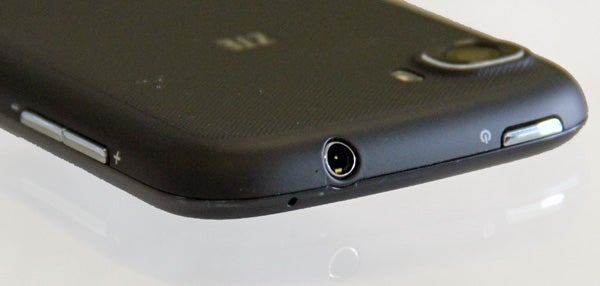
Want to use the phone as a media player? You’ll need to invest in a large microSD card, no doubt. 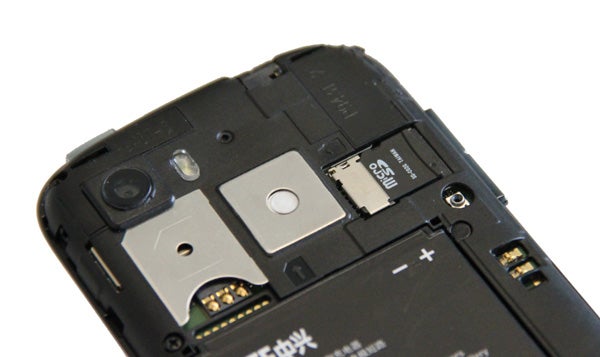
The ZTE Grand X’s wireless connectivity is fairly complete. There’s Bluetooth 4.0, Wi-Fi n, fast HSPA mobile internet, and the usual support for Wi-Fi hotspot creation. NFC does not feature, which is a knock in this phone’s future-proofing armour. NFC stands for Near-Field Communication, and is set to become a common wireless payments standard. It has not spread too far across the high street yet, but once the next iPhone shows it off, you can bet adoption will ramp-up quick-smart.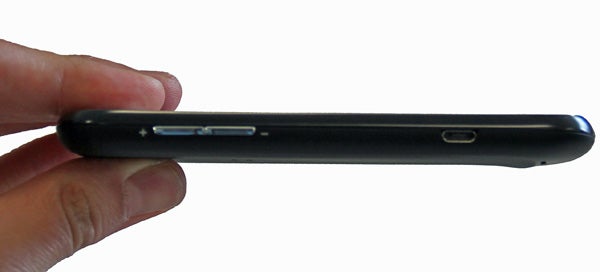
Although this is likely to have been an omission made for the sake of costs, there are precious few of them here. After all, the ZTE Grand X offers active noise cancellation for calls, dual cameras and pretty uncompromised specs. With a Tegra 2 dual-core 1GHz processor and 1GB of RAM, this phone isn’t anywhere near as powerful as a top-end phone like the Samsung Galaxy S3, but it’s no slowcoach either.
Screen
Several phones at a comparable price offer a dual-core processor. The Sony Xperia U and Samsung Galaxy Ace 2 both do. However, neither has the screen to match the ZTE Grand X. 
4.3in across and with a resolution of 540 x 960, its specs are not those of an “affordable” phone. They’re the specs of a top-end phone of last year. That may not sound mighty impressive, but we need to consider that the phone doesn’t sell for anything like a top-end price.
The screen is a TFT LCD model, but its performance is comparable to that of an IPS display, boasting superb viewing angles and solid colour reproduction. The qHD resolution results in pixel density of 256dpi, enough for super-sharp small text but not quite enough to make individual pixels truly invisible – although you have to try pretty hard and get pretty close to see ’em. 
Just the one limitation lingers – top brightness is not dazzling. It’s enough for 95 per cent of eventualities, and there’s an auto brightness setting to let the Grand X manage the backlight itself – but using it in bright sunlight will always be a bit tricky.
The capacitive touchscreen underneath supports five-point multi-touch – far from the most we’ve seen, but easily enough for any common usage. After all, how many fingers can you cram onto a smartphone screen? And no, that’s not a challenge.
Once of the best things about the ZTE Grand X is that it uses a vanilla version of Android 4.0 Ice Cream Sandwich. Although this isn’t the absolutely latest version of the OS – Jelly Bean is out – it is a bit early to expect it in third-party phones. And many rivals still use Android 2.3 Gingerbread.
Ice Cream Sandwich on a phone works well, and poses only a slight learning curve if you’re at all used to the Android OS. It’s retains the basic structure of previous versions of the software, with home screens and a universal apps menu, but updates the look of the interface. It’s more modern, a fair bit cleaner and generally more attractive.
We’re delighted to see the OS in its vanilla form here, too. Changes made by manufacturers are rarely all that beneficial, other than in adding a different visual style or improving social networking integration, as with HTC Sense. And we doubt ZTE would have the software development budget to match HTC’s effort, which has been in continual development for years.
Ice Cream Sandwich runs beautifully on the ZTE Grand X. It’s refreshing to see a phone that sells for under £200 work so smoothly. 
ZTE has made a few small tweaks and additions to a barebones Android install, but it’s nothing you couldn’t do yourself. The most notable is that the standard Android keyboard has been replaced with Touchpal, one of the most popular third-party keyboards.
A 4.3in screen is large enough to make typing comfortable on just about any virtual keyboard, but Touchpal is rather nice. It’s customisable in look and feel, it supports voice dictation and Swype-style input rather than standard key-tapping. This is where you draw a seamless line over the letters in a word, and then the Grand X’s brain works out what you meant to type. 
It works well, and while it’s not for everyone we find it quicker than normal typing a lot of the time.
Apps
A few additional apps come preinstalled too. Facetone is a largely inoffensive piece of fluff that shows a slideshow of your friends’ Facebook photos whenever they call or text you. We’ll pass, thanks, but someone out there might like it.
Android Full Share is a DLNA-based media streaming app. Loads of devices support DLNA these days – and if you have a connected TV there’s a good chance you’ll be able to stream video from your phone to it directly using this app. Evernote also features, and has become the go-to smartphone note-taking app.
And – much more important – the ZTE Grand X has access to the Google Play app store, letting you get your hands on hundreds of thousands of apps. Many of them rubbish, but there are some gems in there.
Games and Performance
Within its “budget-ish” mid-range class, where the phone excels is gaming. The 1GHz Tegra 2 processor of the ZTE Grand X was perhaps the most commonly-used chipset in top-end Android devices in 2011 and as a result oodles of impressive games have been optimised for it. 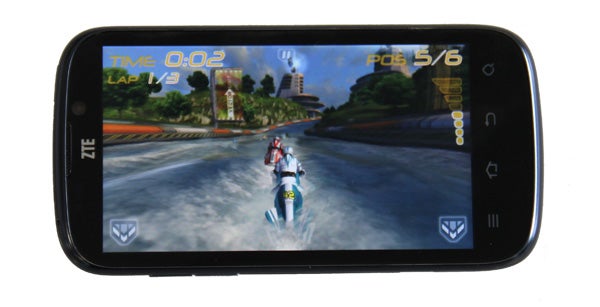
Although it’s a bit of a middle-aged CPU – a bit of white hair starting to appear around its virtual temples now that quad-core Tegra 3 is about – the Tegra 2 lets the ZTE Grand X sail through some of the most impressive Android games available. We tested a fistful of demanding 3D games extensively including Riptide, Shadowgun and Heroes Call, and all performed near-perfectly with virtually no slow-down.
The Tegra Zone portal – which is designed to promote games optimised for Tegra chipsets – does feature a few games that are Tegra 3-only at present, but gaming-centric phones don’t get much better at the price. And, of course, the thousands of more casual games available on Android will pose no problem for the Grand X. Angry Birds ahoy, etc.
However, the phone does get alarmingly warm quite quickly once you really set the Tegra 2 chip to work, with a heat hotspot up near the camera housing. And, predictably, it chomps up the battery life like no-one’s business.
For a less subjective look at the phone’s performance, we set it to some common benchmarks. In the AnTuTu test, it scored 5076 points. This is on-par with similarly-specced devices, such as last year’s Samsung Galaxy Tab 10.1 tablet, meaning it comfortably outperforms the mid-range alternatives from Sony, HTC and co.
Web Browsing
An app-based bonus of the ZTE Grand X’s use of Android 4.0 Ice Cream Sandwich rather than 4.1 Jelly Bean is that the phone can use Adobe Flash Player 11. Support for Flash has been removed in Jelly Bean, because Adobe itself has ceased support for the Android platform.
At the time of writing, the app is still available to download on the Grand X, and it provides the phone with a pretty satisfying browsing experience – Flash is still used for plenty of “rich” online multimedia content.
The phone’s form helps out too. A 4.3in screen is the perfect size for reading websites while out and about – big enough to avoid eyestrain, small enough to hold comfortably in one hand. And the qHD resolution screen keeps fairly small text looking pin-sharp.
Camera
The ZTE Grand X has two cameras at its disposal. There’s a basic VGA user-facing one and a 5MP main sensor on the rear.
This lead sensor ticks many of the right boxes – it uses autofocus with optional touch focusing, has an LED flash to call upon and the camera housing doesn’t look like an afterthought. You can use the volume rocker as a physical camera button too, which is handy as it sits just where a shutter button should. Photo performance is a bit less noteworthy, though. 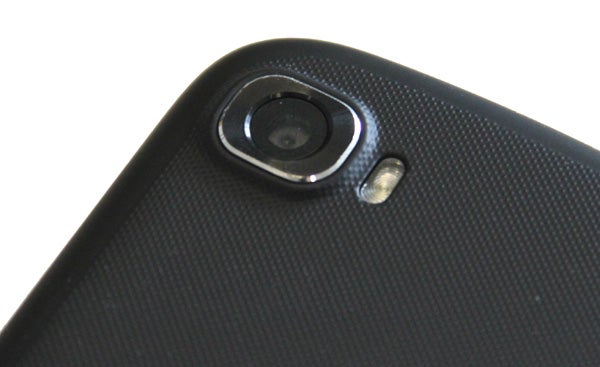
Autofocus speed is reasonably quick in decent light conditions, but the sensor has trouble resolving fine detail. Check it out the pictures below, where the brickwork of a faraway building has been partly turned into mush, and the fine “in focus” detailing of a leaf looks soft. Colours are a little glum-looking, and there’s significant purple fringing throughout. However, for casual snaps to post online, it’ll do the job just fine. 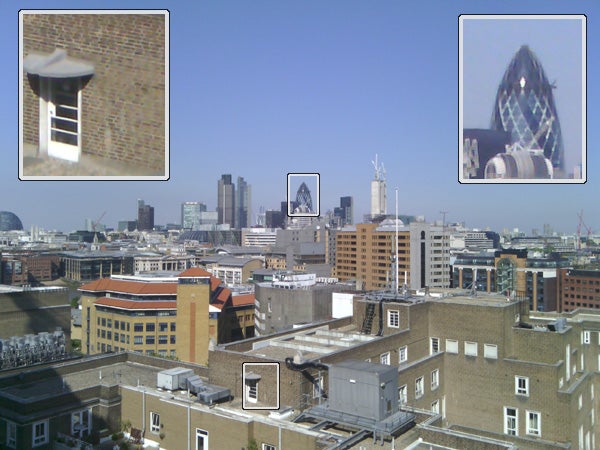

Additional features offered by the camera app are pretty limited. Aside from the bottom-rung basics of exposure compensation and a handful of scene modes, there’s face detection, x4 digital zoom and a panorama mode, but that’s it. There are none of the fun real-time video effects of the Samsung Galaxy Nexus – no advanced effects whatsoever actually – no HDR mode and no in-app photo touch-ups. 
Video capture maxes out at 720p resolution and there’s no continuous autofocus or access to the LED flash light while filming. This is not the most versatile mobile camcorder around.
Video Playback
On the other side of the video fence, the fairly high-res, large screen of the ZTE Grand X should make it a pretty handy little portable media player. And it is, as long as you use the right codec and bit-rate.
Without using a third-party media player, the Grand X can handle standard definition DivX files just fine, and naturally the Android staples of H.264 and WMV will play. However, more challenging video will stutter to the extent that they’re unplayable or refuse to play at all. Most HD videos seem to be a little too much for the Tegra 2 processor to take. 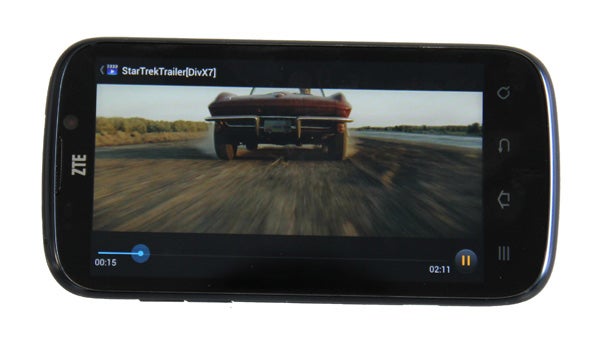
Switching to the alternative MX Player app from Google Play didn’t help matters too much. There simply isn’t quite the power here to software decode HD videos that aren’t supported natively. If you’re willing to transcode videos manually, though, the Grand X will make a fine little pocket video player.
Want to play the Google way? You can rent films from the Google Play store, for £3.49 a pop. Or, if you’re a Netflix member you could always use the Netflix Android app. There’s generally always a way around problems with Android, but base line video skills are a little disappointing here.
Music Player
The ZTE Grand X uses the standard Android Ice Cream Sandwich music player app. It’s simple, and not desperately attractive in parts, but it’s fairly quick. FLAC support is now natively supported by Android, so it’s already audiophile-friendly.
To try and give the phone some audio cred, ZTE has packed Dolby Mobile into the phone. This is a DSP (digital signal processing) app that’s basically just EQ with some minor effects work tied-in. It’s some of the better, more subtle EQ you’ll find in a mobile phone app, but it’s not magic. And we found it added a little treble harshness with some settings. One handy bit, though, is the movie mode, which pushes the central channel to the fore – good for keeping dialogue clear. 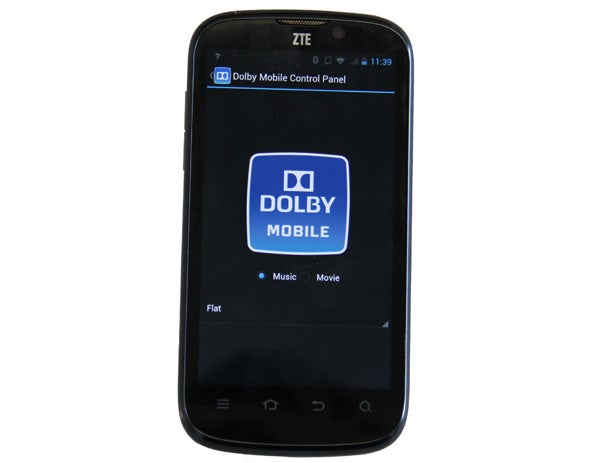
What’s more important in a potential music player is how clean and how loud the signal is. When audio is engaged, there’s a very slight hiss that’s audible with isolating IEM earphones (during silent moments), and maximum volume is only reasonable. We found that when around town, volume had to be ramped-up to near-max for a good listening level.
It almost goes without saying – you will definitely need to invest in a memory card if you want to use the Grand X as a serious music player.
Integrated Speaker
From hi-fi to lo-fi, the ZTE’s internal speaker sits on the back of the phone, piping out through a pair of outlets in the battery cover. No, there aren’t two speaker drivers here, but there is a clever design reason to explain the dual outlets. It ensures that when you hold the phone in landscape – when gaming or watching a video, for example – you won’t muffle the sound completely with your hand. 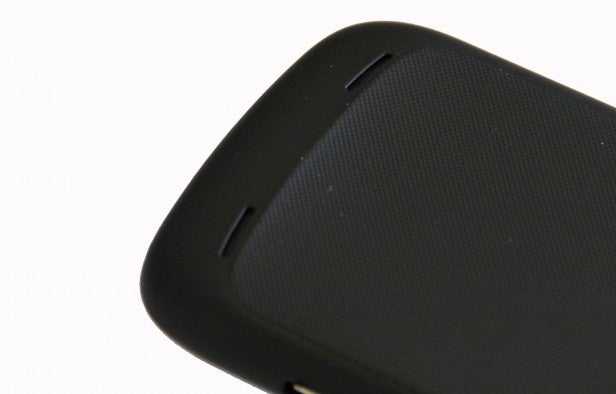
Sound quality isn’t too bad either, with the small amount of warmth and bass that’s found in the best mobile phone speakers. It’s happy to push up to maximum volume without distorting and sounds fairly pleasant with music too. As an element that could easily have been neglected in favour of cost-cutting, we’re impressed the speaker performance is actually pretty good.
Battery Life
The ZTE Grand X has a 1650mAh battery. This is similar to the capacity used in most of HTC’s 4.3in phones, and the phone doesn’t put in a notable stamina showing. We just scraped a full day’s use out of the thing, not helped by a few brief gaming sessions where the phone got worryingly warm. Unless you’re going to turn off 3G mobile internet, this is absolutely a phone you’ll need to charge every day.
Call Quality
Much like the decent internal speaker, the ZTE Grand X surprises once more by offering a good call experience. Voices pipe out loud and clear, with robust output and decent clarity.
The phone also uses a pinhole microphone right next to the 3.5mm headphone jack to offer active noise cancellation – manipulating the signal before it reaches whoever you’re calling to mute the sound of passing traffic, wind and other such conversation-ruining annoyances.
Value
The ZTE Grand X has that traditional ZTE flavour – in that if this phone had a Samsung badge on it, you can bet you’d be paying more. However, it is a significant step up from ZTE’s best-known handsets, the ZTE Skate (aka Orange Monte Carlo) and the ZTE Crescent (aka Orange San Francisco 2). A dual-core 1GHz gets rid of the slight lag that’s a dead giveaway of any phone’s budget origins. 
Very little about the ZTE Grand X looks or feels cheap, and the decision to use a non-customised version of Android Ice Cream Sandwich demonstrates a refreshing lack of egotism on ZTE’s part.
At £190, the price of the phone is not quite jaw-dropping – part of us wishes it could stretch to £149.99. But that is in part because we’d love to see ZTE push the envelope even further. That said, if your budget stretches to £200 and you want an Android, this is about the best you can hope to get right now.
Verdict
The ZTE Grand X sees the budget phone maker up its game once more. A dual-core processor and lean software wipes-out the lag of previous lower-cost ZTE Androids, while neat extras such as noise cancellation on calls and a decent internal speaker further wipe away anything approaching a budget vibe. It doesn’t have quite the design personality of the alternatives from HTC and Sony, but pound-per-pound you get more for your money here.
How we test phones
We test every mobile phone we review thoroughly. We use industry standard tests to compare features properly and we use the phone as our main device over the review period. We’ll always tell you what we find and we never, ever, accept money to review a product.
Trusted Score
Score in detail
-
Camera 7
-
Design 7
-
Value 9
-
Features 8
-
Screen Quality 8


